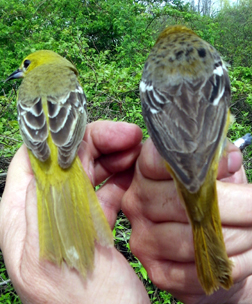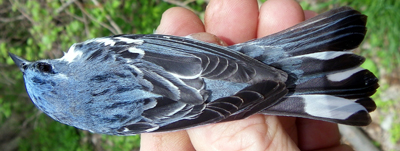One of the pieces of information acquired from this long-term research project is the return of breeding birds to the marsh region of which we capture and document their site fidelity to this important habitat. This week, we captured a Yellow Warbler (YEWA) that was at least eight (8) years old and two that were six (6) years old. A male Common Yellowthroat also returned for his fifth year. This is quite a feat for birds that make a 4,000 plus round trip migration to Central America and back to our marshes each year! It is estimated that most warblers live an average of 3 years, but some definitely beat the odds.
 |
| Male YEWA |
 |
| Female OROR |
 |
| Female BAOR |
 |
| Front of OROR and BAOR female |
 |
| Backs of OROR and BAOR females |

 |
| Back of the CERW- a view that most people do not get to see |
Next week the second pulse of the second wave of migrants is expected to occur when the winds shift to the southwest. We look forward to many Magnolia Warblers and Swainson's Thrushes with an increase in redstarts and many other warbler species.
Enjoy the great days of spring!
Check out the Navarre Banding totals at http://www.bsbo.org/passerine/spring_passerine_migration_monitoring.htm


No comments:
Post a Comment